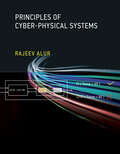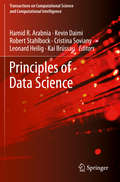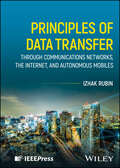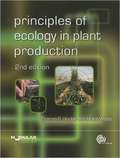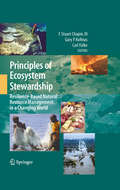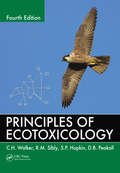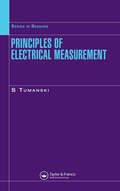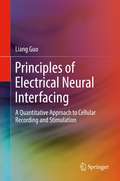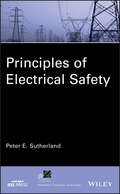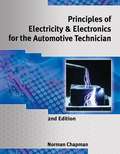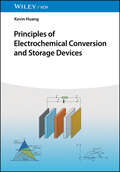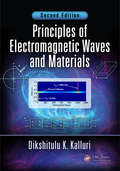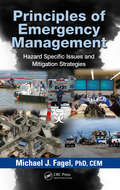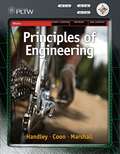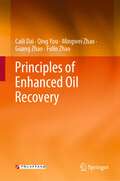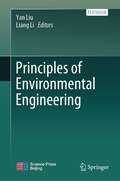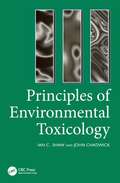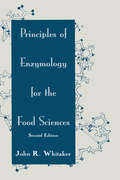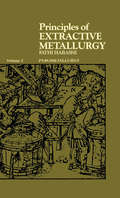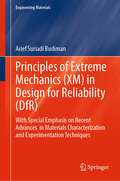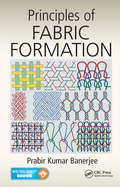- Table View
- List View
Principles of Cyber-Physical Systems
by Rajeev AlurA foundational text that offers a rigorous introduction to the principles of design, specification, modeling, and analysis of cyber-physical systems.A cyber-physical system consists of a collection of computing devices communicating with one another and interacting with the physical world via sensors and actuators in a feedback loop. Increasingly, such systems are everywhere, from smart buildings to medical devices to automobiles. This textbook offers a rigorous and comprehensive introduction to the principles of design, specification, modeling, and analysis of cyber-physical systems. The book draws on a diverse set of subdisciplines, including model-based design, concurrency theory, distributed algorithms, formal methods of specification and verification, control theory, real-time systems, and hybrid systems, explaining the core ideas from each that are relevant to system design and analysis.The book explains how formal models provide mathematical abstractions to manage the complexity of a system design. It covers both synchronous and asynchronous models for concurrent computation, continuous-time models for dynamical systems, and hybrid systems for integrating discrete and continuous evolution. The role of correctness requirements in the design of reliable systems is illustrated with a range of specification formalisms and the associated techniques for formal verification. The topics include safety and liveness requirements, temporal logic, model checking, deductive verification, stability analysis of linear systems, and real-time scheduling algorithms. Principles of modeling, specification, and analysis are illustrated by constructing solutions to representative design problems from distributed algorithms, network protocols, control design, and robotics.This book provides the rapidly expanding field of cyber-physical systems with a long-needed foundational text by an established authority. It is suitable for classroom use or as a reference for professionals.
Principles of Cyber-Physical Systems: An Interdisciplinary Approach
by Sajal K. Das Sandip RoyThis unique introduction to the foundational concepts of cyber-physical systems (CPS) describes key design principles and emerging research trends in detail. Several interdisciplinary applications are covered, with a focus on the wide-area management of infrastructures including electric power systems, air transportation networks, and health care systems. Design, control and optimization of cyber-physical infrastructures are discussed, addressing security and privacy issues of networked CPS, presenting graph-theoretic and numerical approaches to CPS evaluation and monitoring, and providing readers with the knowledge needed to operate CPS in a reliable, efficient, and secure manner. Exercises are included. This is an ideal resource for researchers and graduate students in electrical engineering and computer science, as well as for practitioners using cyber-physical systems in aerospace and automotive engineering, medical technology, and large-scale infrastructure operations.
Principles of Data Science (Transactions on Computational Science and Computational Intelligence)
by Hamid R. Arabnia Robert Stahlbock Kevin Daimi Cristina Soviany Leonard Heilig Kai BrüssauThis book provides readers with a thorough understanding of various research areas within the field of data science. The book introduces readers to various techniques for data acquisition, extraction, and cleaning, data summarizing and modeling, data analysis and communication techniques, data science tools, deep learning, and various data science applications. Researchers can extract and conclude various future ideas and topics that could result in potential publications or thesis. Furthermore, this book contributes to Data Scientists’ preparation and to enhancing their knowledge of the field. The book provides a rich collection of manuscripts in highly regarded data science topics, edited by professors with long experience in the field of data science.Introduces various techniques, methods, and algorithms adopted by Data Science expertsProvides a detailed explanation of data science perceptions, reinforced by practical examplesPresents a road map of future trends suitable for innovative data science research and practice
Principles of Data Transfer Through Communications Networks, the Internet, and Autonomous Mobiles
by Izhak RubinUnderstand the principles and practical basis of global telecommunications and data communications networks with this essential text Our increasingly connected world is more reliant than ever on data transport and the communication networking technologies of the moment. Ever-expanding wireless communications and the Internet of Things have brought connectivity into more areas of our lives than ever before. Virtually every workplace and industry is now reliant at some level on data transfer. Principles of Data Transfer through Communications Networks, the Internet, and Autonomous Mobiles offers a comprehensive yet accessible overview of the principles and methods of computer communications and mobile wireless network systems. It’s designed to equip a vast range of students and professionals with the necessary toolkit to manage data flows between and across network systems at various scales. Drawing upon decades of teaching and practical experience, it’s a must-own resource for anyone looking to understand the core mechanics that power our world of mass communications. Readers will also find: Coverage of cutting-edge technologies such as autonomous vehicular highways that draw upon novel communications technologiesDetailed discussion of design and performance behavior for major communication networking technologiesTreatment designed for readers with no prior knowledge of computer science or programming Principles of Data Transfer through Communications Networks, the Internet, and Autonomous Mobiles is ideal for students in data communications, telecommunications and wireless networking technology courses, as well as professionals working in data communications industries or those who make use of data transfer communications networks as part of their work.
Principles of Digital Communication
by Robert G. GallagerThe renowned communications theorist Robert Gallager brings his lucid writing style to the study of the fundamental system aspects of digital communication for a one-semester course for graduate students. With the clarity and insight that have characterized his teaching and earlier textbooks, he develops a simple framework and then combines this with careful proofs to help the reader understand modern systems and simplified models in an intuitive yet precise way. A strong narrative and links between theory and practice reinforce this concise, practical presentation. The book begins with data compression for arbitrary sources. Gallager then describes how to modulate the resulting binary data for transmission over wires, cables, optical fibers, and wireless channels. Analysis and intuitive interpretations are developed for channel noise models, followed by coverage of the principles of detection, coding, and decoding. The various concepts covered are brought together in a description of wireless communication, using CDMA as a case study.
Principles of Digital Communication and Coding (Dover Books on Electrical Engineering)
by Jim K. Omura Andrew J. ViterbiWritten by two distinguished experts in the field of digital communications, this classic text remains a vital resource three decades after its initial publication. Its treatment is geared toward advanced students of communications theory and to designers of channels, links, terminals, modems, or networks used to transmit and receive digital messages.The three-part approach begins with the fundamentals of digital communication and block coding, including an analysis of block code ensemble performance. The second part introduces convolutional coding, exploring ensemble performance and sequential decoding. The final section addresses source coding and rate distortion theory, examining fundamental concepts for memoryless sources as well as precepts related to memory, Gaussian sources, and universal coding. Appendixes of useful information appear throughout the text, and each chapter concludes with a set of problems, the solutions to which are available online.
Principles of Ecology in Plant Production
by Thomas Sinclair Albert Weiss Franklin GardnerProduction of food fibre and fuel is vital for humanity, and as the world population continues to rise, demands on these resources is ever increasing. In a context of growing worldwide concern about sustainability and environmental impacts of cropland, grassland and forestry practices, this textbook provides an introduction to the processes that define the ecology and environment of plant production. Core principles are examined such as soil-plant relationships, genetic manipulation and diversity, yield and water requirements, as well as physical factors such as solar radiation, temperature and weather. Fully updated with new chapters on climate change and biofuels, this edition is an important text for students and researchers in agronomy, forestry, botany, ecology and environmental sciences. Praise for the first edition: 'I highly recommend this book for undergraduate students in plant production courses. It is easy to read, well-structured and of high scientific level...also useful for a more general readership' Scientia Horticulturae
Principles of Ecosystem Stewardship
by Gary P. Kofinas M. C. Chapin F. Stuart Chapin III Carl FolkeThis is a textbook for Natural Resource Management, Resource Conservation and Ecosystem Management, as well as other related or more specialized courses. Most textbooks on natural resource and ecosystem management are dominated by a steady-state view that interprets change as gradual and incremental and disregards interactions across scales. Management implementation of steady-state theory and policies tends to invest in controlling a few selected ecosystem processes, at the expense of long-term social-ecological resilience - i.e., the capacity of the system to cope with surprise and abrupt changes. Loss of resilience makes systems more vulnerable to both expected and unforeseen changes. Achieving desirable outcomes for humanity, such as those of the UN Millennium Development Goals on poverty, food security, and environmental sustainability, will require new integrated and adaptive approaches to social and economic development, where the complex interconnectedness between humans and nature, at all scales, is considered and the existence of uncertainty and surprise accepted as the rule. The purpose of this textbook is to provide a new framework for resource management - a framework based on the necessity of managing resources in a world dominated by uncertainty and change. The book links recent advances in the theory of resilience, sustainability, and vulnerability with practical issues of resource management.
Principles of Ecotoxicology
by C.H. Walker R.M. Sibly D.B. PeakallCutting across traditional subject boundaries, Principles of Ecotoxicology, Fourth Edition gives readers an integrated view of ecotoxicology, from molecules to ecosystems. This new edition of a bestselling textbook continues to emphasize principles rather than practice, providing the interdisciplinary perspective and grounding required for research
Principles of Electrical Measurement
by Slawomir TumanskiThe field of electrical measurement continues to grow, with new techniques developed each year. From the basic thermocouple to cutting-edge virtual instrumentation, it is also becoming an increasingly "digital" endeavor. Books that attempt to capture the state-of-the-art in electrical measurement are quickly outdated. Recognizing the need for a tex
Principles of Electrical Neural Interfacing: A Quantitative Approach to Cellular Recording and Stimulation
by Liang GuoThis textbook fills a gap to supply students with the fundamental principles and tools they need to perform the quantitative analyses of the neuroelectrophysiological approaches, including both conventional and emerging ones, prevalently used in neuroscience research and neuroprosthetics. The content grows out of a course on Neuroengineering and Neuroprosthetics, which the author has taught already several times. The key problems the author addresses include (1) the universal operating mechanisms of neuroelectrophysiological approaches, (2) proper configuration of each approach, and (3) proper interpretation of the resulting signals. Efforts are made both to extract the universal principles underlying this common class of approaches and discern the unique properties of each individual approach. To address these important problems, equivalent electrical circuit modeling and signal analysis are used to unravel the functioning mechanisms and principles and provide sound interpretations to the associated signals and phenomena. This book aims to derive analytical solutions to these equivalent circuits, which can offer clear and complete mechanistic insights to the underlying biophysics.
Principles of Electrical Safety (IEEE Press Series on Power Engineering)
by Peter E. SutherlandPrinciples of Electrical Safety discusses current issues in electrical safety, which are accompanied by series' of practical applications that can be used by practicing professionals, graduate students, and researchers. . <P><P>* Provides extensive introductions to important topics in electrical safety * Comprehensive overview of inductance, resistance, and capacitance as applied to the human body * Serves as a preparatory guide for today's practicing engineers
Principles of Electricity and Electronics for the Automotive Technician (2nd Edition)
by Norm ChapmanPrinciples of Electricity & Electronics for the Automotive Technician, 2E thoroughly covers the basics of automotive electricity and electronics to fully prepare beginning technicians for more complex electrical concepts. Written by an ASE Master Technician and teacher, the book draws readers in using a combination of basic theory, case studies, hands-on vehicle tasks and ASE-style review questions. The updated second edition includes expanded coverage of hybrid electrical vehicles and safety procedures, technological advances in electronically controlled vehicle accessories, and new troubleshooting techniques using cutting-edge equipment and procedures. Simple illustrations and wiring diagrams, along with straightforward explanations of how automotive electricity and electronics work, act together to make this an ideal introduction to electrical and electronics diagnostics and service.
Principles of Electrochemical Conversion and Storage Devices
by Kevin HuangComprehensive resource covering fundamental principles of electrochemical energy conversion and storage technologies including fuel cells, batteries, and capacitors Starting with the importance and background of electrochemical foundations, Principles of Electrochemical Conversion and Storage Devices explains the working principles and electrochemistry of electrochemical cells. After a summary of thermodynamic and kinetics, different types of fuel cells as well as batteries and capacitors are covered. This book is written in the style of a textbook, providing illustrative examples and inspiring problems to facilitate the understanding of essential principles of electrochemical cells while offering practical insights for research pursuits. Various application examples are provided at the end of each chapter to strengthen reader understanding of energy storage from a practical point of view. Written by a highly qualified and awarded academic and based on a culmination of his two decades of personal teaching and research experience in the field, Principles of Electrochemical Conversion and Storage Devices includes information on: Common reference electrodes and potentials, standard electrode potentials in aqueous solutions, and current functions for the charge transfer processStandard Gibbs free energy of formation of selected compounds, standard heat of combustion of common fuels, and commonly used physical constantsLatest developments in the field, especially surrounding clean energy technologies, and various experimental methods essential for conducting rigorous electrochemical researchCharacterizing methods, key materials, and governing principles behind all of the covered devices Providing comprehensive coverage of the subject, Principles of Electrochemical Conversion and Storage Devices is an excellent resource tailored for researchers and students from all technical and natural science disciplines seeking to understand more about the most promising energy-related devices and the potential they hold to change the world.
Principles of Electromagnetic Waves and Materials
by Dikshitulu K. KalluriThis book focuses primarily on senior undergraduates and graduates in Electromagnetics Waves and Materials courses. The book takes an integrative approach to the subject of electromagnetics by supplementing quintessential "old school" information and methods with instruction in the use of new commercial software such as MATLAB. Homework problems, PowerPoint slides, an instructor’s manual, a solutions manual, MATLAB downloads, quizzes, and suggested examination problems are included. Revised throughout, this new edition includes two key new chapters on artificial electromagnetic materials and electromagnetics of moving media.
Principles of Emergency Management: Hazard Specific Issues and Mitigation Strategies
by Michael J. FagelPrinciples of Emergency Management: Hazard Specific Issues and Mitigation offers preparedness and mitigation recommendations for advanced emergency planning. Because disasters are so unpredictable, advance planning is needed to effectively respond to and mitigate against the potential effects of such events.Whether a disaster is natural or man-made
Principles of Engineering
by Brett A. Handley David M. Marshall Craig CoonPRINCIPLES OF ENGINEERING will help readers better understand the engineering concepts, mathematics, and scientific principles that form the foundation of the Project Lead the Way (PLTW) Principles Of Engineering course. Important concepts and processes are explained throughout using full-color photographs and illustrations. Appropriate for high school students, the mathematics covered includes algebra and trigonometry. Strong pedagogical features to aid comprehension include: Case Studies, boxed articles such as Fun Facts and Points of Interest, Your Turn activities, suggestions for Off-Road Exploration, connections to STEM concepts, Career Profiles, Design Briefs, and example pages from Engineers' Notebooks. Each chapter concludes with questions designed to test the reader's knowledge of information presented in the chapter, along with a hands-on challenge or exercise that compliments the content and lends itself to exploration. Key vocabulary terms are highlighted throughout the book and emphasized in margin definitions.
Principles of Enhanced Oil Recovery
by Caili Dai Fulin Zhao Qing You Mingwei Zhao Guang ZhaoThis book presents the latest progress in enhanced oil recovery technology and introduces the application of various enhanced oil recovery methods in oilfield development. Enhanced oil recovery (EOR) is a continuous theme in oilfield development. Due to the influence of geological conditions, development mode and physical and chemical factors, more than half of the proven oil reserves remain underground and cannot be accessed. Therefore, many enhanced oil recovery methods have been developed to achieve higher oil recovery. This book presents the basic principles and provides the chemistry knowledge related to enhanced oil recovery. It also expounds the applicable criteria of chemical agents. In addition, combined with field application examples, the limitations of existing enhanced oil recovery methods are analyzed, and the future development direction of enhanced oil recovery technology is highlighted. It is worth noting that the integral profile control and water shutoff technology in this book is widely recognized in the enhanced oil recovery industry and has achieved remarkable economic benefits. Given its scope, this book is useful for the scientific and technical personnel engaged in the study of oil recovery chemistry and enhanced oil recovery and also as a teaching reference for teachers and students majoring in petroleum engineering and oilfield chemistry.
Principles of Environmental Engineering
by Yan Liu Liang LiThis textbook contains the contents coming from hydraulics, hydrodynamics, chemical principles, chemical reaction engineering and bioengineering, which relates closely with fundamental principles in environmental engineering. It mainly covers principles including basic concepts, theories, methods and related equipment in fluid flow and transportation, heat transfer, absorption, chemical and biological reaction kinetics and reactors, as well as their applications in environmental engineering. At same time, the readers learns the basic viewpoints and methods commonly used in engineering technology, such as balance method, reasonable simplification, dimensional analysis method, boundary layer theory, optimization and mathematical model method. It broadens the student’s understanding in solving those problems in environmental engineering, and enhances their awareness of industrialization. This book is the specialized foundation and principles for learning the professional courses of environmental engineering, such as "water pollution control," "air pollution control," "solid waste treatment and disposal" and "ecological restoration engineering", while avoiding the repetition of the contents of those professional books.
Principles of Environmental Toxicology
by J. Chadwick I. ShawEnvironmental toxicology is the study of the action of chemicals upon ecosystems. Understanding the effects of exogenous chemicals upon the inhabitants of an ecosystem may enable us to predict and possibly prevent their deleterious effects. This textbook provides a good general introduction to all the major areas of environmental toxicology, including the fate of chemicals in the environment, environmental toxicity testing, risk assessment, radioactivity in the environment, legislation, environmental monitoring and the future impact of industrial development on the environment. It is written in an informal, accessible style with many examples of environmental issues taken from the author's personal experience and will provide students and other interested individuals with a broad overview of the science of environmental toxicology.
Principles of Enzymology for the Food Sciences (Food Science And Technology Ser. #61)
by John R. WhitakerThis second edition explains the fundamentals of enzymology and describes the role of enzymes in food, agricultural and health sciences. Among other topics, it provides new methods for protein determination and purification; examines the novel concept of hysteresis; and furnishes new information on proteases, oxidases, polyphenol oxidases, lipoxygenases and the enzymology of biotechnology.
Principles of Extractive Metallurgy: An Introduction To Extractive Metallurgy (Morgan Kaufmann Series In Data Management Systems)
by F. Habashi"First Published in 2017. Routledge is an imprint of Taylor & Francis, an Informa company."
Principles of Extreme Mechanics: With Special Emphasis on Recent Advances in Materials Characterization and Experimentation Techniques (Engineering Materials)
by Arief Suriadi BudimanThis book addresses issues pertinent to mechanics and stress generation, especially in recent advanced cases of technology developments, spanning from micrometer interconnects in solar photovoltaics (PV), next-gen energy storage devices to multilayers of nano-scale composites enabling novel stretchable/flexible conductor technologies. In these cases, the mechanics of materials have been pushed to the extreme edges of human knowledge to enable cutting-edge, unprecedented functionalities and technological innovations. Synchrotron X-ray diffraction, in situ small-scale mechanical testing combined with physics-based computational modeling/simulation, has been widely used approaches to probe these mechanics of the materials at their extreme limits due to their recently discovered distinct advantages. The techniques discussed in this manuscript are highlights specially curated from the broad body of work recently reported in the literature, especially ones that the author had led the pursuits at the frontier himself. Extreme stress generation in these advanced material leads to often new failure modes, and hence, the reliability of the final product is directly affected. From the recent topics and various advanced case studies covered in this book, the reader gets an updated knowledge of how new mechanics can and has been applied in Design-for-Reliability (DfR) for some of the latest technological innovations known in our modern world. Further, this also helps in building better designs, which may avoid the pitfalls of the current practiced trends.
Principles of Fabric Formation
by Prabir Kumar BanerjeeTextile fabrics of various structures are being increasingly used by engineers of different disciplines. This junior/senior undergraduate-level textbook focuses on the diverse technical principles involved at each stage of the formation of different types of fabrics. The book covers topics such as winding, warping, sizing, woven fabric construction, weaving, weft knitting, warp knitting, braiding, nonwovens, triaxial, multiaxial, and 3-D fabrics. A solutions manual is also available upon qualifying course adoption.
Principles of Fire Behavior (Career Education Ser.)
by James G. QuintiereThis text covers the four forms of fire: diffusion flames, smoldering, spontaneous combustion, and premixed flames. Using a quantitative approach, the text introduces the scientific principles of fire behavior, with coverage of heat transfer, ignition, flame spread, fire plumes, and heat flux as a damage variable. Cases, examples, problems, selected color illustrations and review of mathematics help students in fire safety and investigation understand fire from a scientific point of view.
